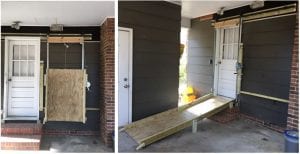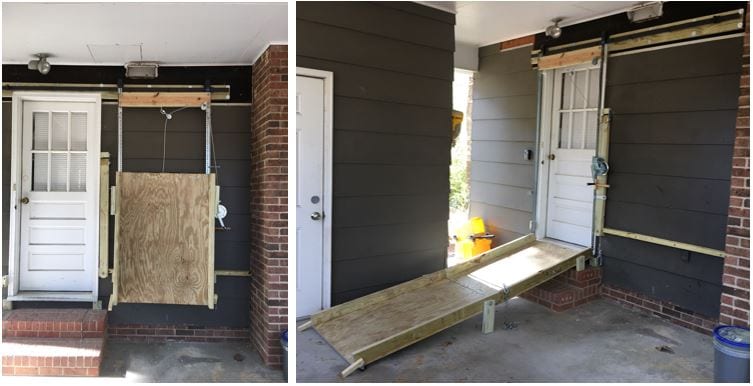Darshana Jaint, Kailani Montane
 Permanent ramps are required by the ADA to be 12 in. in length for every in of incline. Following this method, the ramp part of our device would have been 18.5 ft. long and would leave little space in the residents’ garage. Portable ramps are expensive, steep, and do not provide enough stability to keep everyone who uses them safe. The main goal of this project was to create a ramp that can be easily moved out of the way when not in use, and will allow a home to become safely accessible for people who use wheelchairs. The three key features of the device are that the user can get into and out of the house safely and stably; that the device is easy for staff to set up, use, and stow when done; and that the ramp part of the device does not take up too much space in its open and closed positions. This was accomplished by creating a retractable ramp that is attached to a barn-door mechanism which allows the ramp to slide into and out of place. The device is expected to be crucial for anyone who uses a wheelchair and wants to enter a house that is not accessible. The device can be easily stowed, and will not interfere with the spatial demands of a household, but can also be extended to use as a safe, reliable, and accessible ramp for visitors and residents who use wheelchairs.
Permanent ramps are required by the ADA to be 12 in. in length for every in of incline. Following this method, the ramp part of our device would have been 18.5 ft. long and would leave little space in the residents’ garage. Portable ramps are expensive, steep, and do not provide enough stability to keep everyone who uses them safe. The main goal of this project was to create a ramp that can be easily moved out of the way when not in use, and will allow a home to become safely accessible for people who use wheelchairs. The three key features of the device are that the user can get into and out of the house safely and stably; that the device is easy for staff to set up, use, and stow when done; and that the ramp part of the device does not take up too much space in its open and closed positions. This was accomplished by creating a retractable ramp that is attached to a barn-door mechanism which allows the ramp to slide into and out of place. The device is expected to be crucial for anyone who uses a wheelchair and wants to enter a house that is not accessible. The device can be easily stowed, and will not interfere with the spatial demands of a household, but can also be extended to use as a safe, reliable, and accessible ramp for visitors and residents who use wheelchairs.
